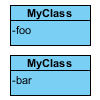Creating Constructor to a UML class
Other tools often require users to go through a cumbersome process to create constructors. In contrast, Visual Paradigm enables users to create constructors effortlessly via a user-friendly pop-up menu.
Other tools often require users to go through a cumbersome process to create constructors. In contrast, Visual Paradigm enables users to create constructors effortlessly via a user-friendly pop-up menu.
The alternative combined fragment is utilized in a sequence diagram to define a section of a cluster of lifelines/actors, representing conditional flow. It also models if-then-else logic in the sequence diagram. This article will exhibit the process of creating a basic sequence diagram using an alternative combined fragment.
A class diagram shows a set of classes, interfaces and their relationships and illustrates the static design view of a system, while a sequence diagram shows the sequence of actions that occurs in a system and illustrates the dynamic view of a system. With Visual Paradigm Desktop, you can easily share the models between class diagram and sequence diagram. The changes that made in the sequence diagram can be automatically added to the class diagram as well and vice versa.
When reversing Java code to sequence diagram, sometimes you may not be able to specify a method for conversion. In the window, somehow the class (to which the method belongs) can’t seem to be expanded to list anything and therefore the method is nowhere to be selected. What happens?
What you need to do to reverse engineer UML sequence diagram from Java code is to select the source folder first, and then pick-up an operation from the identified classes. Visual Paradigm will form a sequence diagram by analyzing the operation you selected. A frequently asked question about this process is “Why aren’t there any operations?” We are going to answer you why in this article.
 Stereotype is an extension mechanism you can use to define new model elements. In Visual Paradigm you can apply stereotype on both UML and BPMN elements.
Stereotype is an extension mechanism you can use to define new model elements. In Visual Paradigm you can apply stereotype on both UML and BPMN elements.
With the import/export stereotypes utility, you can easily share stereotypes’ definition with colleagues without having to re-configure them again from scratch. If conflicts are detected when importing stereotypes, you can select to resolve them to ensure important configurations are not accidentally overwritten by other team members.
Very often when a project was started for some time, a lot of model elements are created, and most of them are placed at root. This not only makes the searching of model elements become difficult, but it also slow down the application because Visual Paradigm tries to load all root level model elements on start up.
To solve the problem, it is recommended to keep the root clean by organizing project data with models or packages, while model is more preferred. When you right click on the project root in Model Structure tree in Project Browser, you can see the menu Model, which lets you create a model. Read more
 Users are not allowed to give same name to two different UML classes when the classes are put under the same parent. It is like you cannot have two physical files with same name in same directory, or having two Java classes with same name under same package.
Users are not allowed to give same name to two different UML classes when the classes are put under the same parent. It is like you cannot have two physical files with same name in same directory, or having two Java classes with same name under same package.
If you really need to draw two different classes in a class diagram but with same name, please check if you are really doing something legit. This article is written to give you some helps.
Read more
 Association is one of the key elements for constructing class model. It is not just a line relating 2 classes but also carrying lots of information describing their relationship. Giving a meaningful name to the association would help to make it easier to understand. Visual Paradigm allows you to show and hide the name of the association in a flexible way. Read more
Association is one of the key elements for constructing class model. It is not just a line relating 2 classes but also carrying lots of information describing their relationship. Giving a meaningful name to the association would help to make it easier to understand. Visual Paradigm allows you to show and hide the name of the association in a flexible way. Read more
When creating a class diagram, sometimes we would draw it using the diagram toolbar and there are times we would reuse elements by drag & drop. However, when you start from scratch, sometimes it can be difficult to know which class goes with which because we may not necessarily know all relationships among them.
